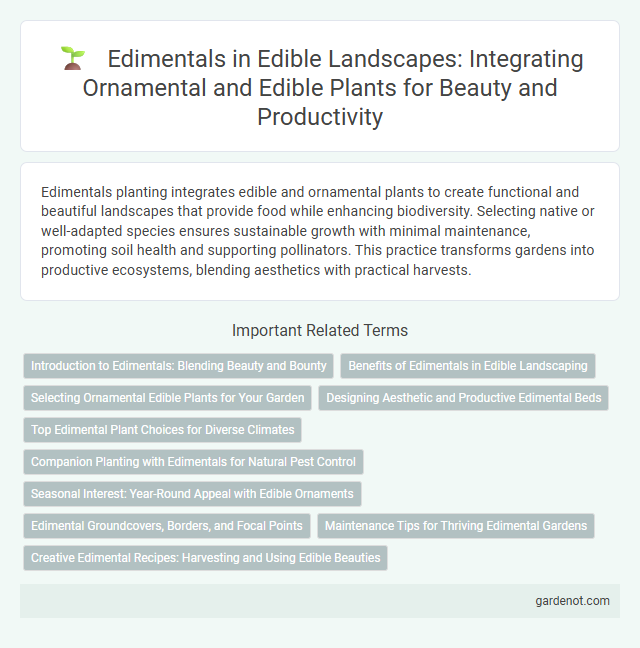Edimentals planting integrates edible and ornamental plants to create functional and beautiful landscapes that provide food while enhancing biodiversity. Selecting native or well-adapted species ensures sustainable growth with minimal maintenance, promoting soil health and supporting pollinators. This practice transforms gardens into productive ecosystems, blending aesthetics with practical harvests.
Introduction to Edimentals: Blending Beauty and Bounty
Edimentals are edible plants that merge aesthetic appeal with nutritional benefits, transforming traditional gardens into functional landscapes that provide both beauty and bounty. These plants include a diverse range of herbs, flowers, and foliage, chosen for their unique flavors, textures, and visual interest, making them ideal for sustainable edible landscaping. Incorporating edimentals enhances biodiversity while offering fresh, homegrown ingredients for culinary use, supporting an eco-friendly and productive garden environment.
Benefits of Edimentals in Edible Landscaping
Edimentals contribute significantly to edible landscaping by enhancing biodiversity and providing a diverse range of flavors and nutrients. Their adaptability to various climates reduces maintenance needs while supporting pollinators and beneficial insects. Integrating edimentals into garden designs not only improves soil health but also creates visually appealing, productive outdoor spaces.
Selecting Ornamental Edible Plants for Your Garden
Selecting ornamental edible plants for your garden involves choosing species that combine aesthetic appeal with culinary value, such as colorful chard, vibrant nasturtiums, and fragrant herbs like rosemary. Prioritize plants that thrive in your local climate and soil conditions, ensuring year-round harvests and visual interest. Incorporating diverse textures and flavors enhances both the garden's beauty and your kitchen's ingredients.
Designing Aesthetic and Productive Edimental Beds
Edimentals planting integrates diverse edible flowers and herbs to create visually striking and highly productive garden beds that maximize both beauty and harvest. Strategic layering of colors, textures, and growth habits enhances the aesthetic appeal while supporting optimal sunlight exposure and soil health for vigorous plant growth. Incorporating perennial edibles and seasonal varieties in well-planned layouts ensures continuous yield and vibrant garden dynamics throughout the growing season.
Top Edimental Plant Choices for Diverse Climates
Edimentals such as sea kale (Crambe maritima), Good King Henry (Blitum bonus-henricus), and Egyptian walking onions (Allium proliferum) thrive in diverse climates due to their adaptability and nutrient density. These plants not only enrich edible landscapes with perennial yields but also require minimal maintenance, making them ideal for sustainable gardening. Incorporating drought-tolerant species like sorrel (Rumex acetosa) and cold-hardy varieties like lovage (Levisticum officinale) ensures year-round production across varying environmental conditions.
Companion Planting with Edimentals for Natural Pest Control
Edimentals, such as borage, nasturtium, and chives, play a vital role in companion planting within edible landscapes by naturally repelling common pests like aphids, whiteflies, and nematodes. Integrating these plants alongside vegetables and fruit crops enhances biodiversity and promotes beneficial insect populations, which improves pest control without chemical intervention. This sustainable approach reduces crop damage, supports plant health, and boosts overall garden productivity.
Seasonal Interest: Year-Round Appeal with Edible Ornaments
Edimentals planting transforms edible landscapes by incorporating colorful herbs, vegetables, and flowers that provide seasonal interest throughout the year. Varieties such as kale, Swiss chard, and nasturtiums offer vibrant foliage and edible blossoms that serve as natural decorations from spring to winter. This approach combines functionality and aesthetics, ensuring continuous visual appeal while supplying fresh, organically grown ingredients.
Edimental Groundcovers, Borders, and Focal Points
Edimental groundcovers such as wild strawberries, creeping thyme, and sorrel create dense, low-maintenance layers that suppress weeds while providing edible harvests. For borders, plants like chives, nasturtiums, and lovage add vibrant color and texture while offering culinary use in salads and garnishes. Focal points can be established with larger edibles like artichokes, rhubarb, or kale, combining visual appeal with seasonal harvests that enhance the garden's productivity and aesthetics.
Maintenance Tips for Thriving Edimental Gardens
Regular pruning and timely harvesting are essential for maintaining vigorous growth in edimental gardens, as they prevent overcrowding and promote healthy air circulation. Mulching with organic materials helps retain soil moisture, suppress weeds, and improve nutrient availability, supporting the diverse needs of edible perennials. Consistent monitoring for pests and diseases alongside appropriate organic treatments ensures the longevity and productivity of edimental plantings.
Creative Edimental Recipes: Harvesting and Using Edible Beauties
Harvesting Edimentals at peak ripeness ensures maximum flavor and nutritional value, perfect for vibrant, creative recipes that showcase their unique tastes and textures. Incorporate a variety of leaves, flowers, and fruits from your edible landscape to craft salads, infusions, and garnishes that elevate everyday meals with natural, homegrown beauty. Exploring seasonal edimentals encourages sustainable cooking practices and deepens your connection to the edible landscape's diverse palette.
Edimentals planting Infographic

 gardenot.com
gardenot.com